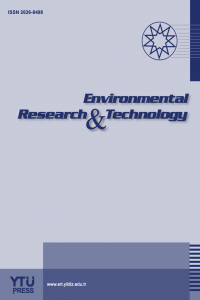Adsorption of 2,4-Dichlorophenoxyacetic Acid on Peanut Shells: Effect of Initial Concentration
Adsorption of 2,4-Dichlorophenoxyacetic Acid on Peanut Shells: Effect of Initial Concentration
Pesticide Adsorption, Peanut shell,
___
- [1]. Z. Al-Qodah, A.T. Shawaqfeh, and W.K. Lafi, “Adsorption of pesticides from aqueous solutions using oil shale ash,” Desalination, vol. 208, pp. 294–305, 2007.
- [2]. V.K. Gupta, I. Ali, Suhas, and V.K. Saini, “Adsorption of 2,4-D and carbofuran esticides using fertilizer and steel industry wastes,” Journal of Colloidal and Interface Science, vol. 299, pp. 556–563, 2006.
- [3]. M. Khoshnood, and S. Azizian, “Adsorption of 2,4-dichlorophenoxyacetic acid pesticide by graphitic carbon nanostructures prepared from biomasses,” Journal of Industrial and Engineering Chemistry, vol. 18, pp. 1796–1800, 2012.
- [4]. J. Gao, G. Zhao, M. Liu, D. Li, “Mechanism of Enhanced Electrochemical Oxidation of 2,4-dichlorophenoxyacetic Acid with in situ Microwave Activated Boron-doped Diamond and Platinum Anodes,” Journal of Physical Chemistry A, vol. 113, pp. 10466-10473, 2009.
- [5]. M. Alvarez., T. Lo ́ pez, J.A. Odriozola, M.A. Centeno, M.I. Domı ́nguez, M. Quintana, D.H. Aguilar, R.D. Gonza ́lez, “2,4-Dichlorophenoxyacetic acid (2,4-D) photodegradation using an Mn+/ZrO2 photocatalyst: XPS, UV– vis, XRD characterization,” Applied Catalysis B, vol. 73, pp. 34-41, 2007.
- [6]. J.L. Acero, F. Javier Benitez, F.J. Real, C. Maya, “Oxidation of Acetamide Herbicides in Natural Waters by Ozone and by the Combination of Ozone/Hydrogen Peroxide: Kinetic Study and Process Modeling,” Industrial and Engineering Chemistry Research, vol. 42, pp. 5762-5769, 2003.
- [7]. H. El Bakouri, J. Usero, J. Morillo, R. Rojas, A. Ouassini, “Drin pesticides removal from aqueous solutions using acid-treated date stones,” Bioresource Technology, vol. 100, pp. 2676-2684 2009.
- [8]. H. El Bakouri, J. Usero, J. Morillo, A. Ouassini, “Adsorptive features of acid-treated olive stones for drin pesticides: Equilibrium, kinetic and thermodynamic modeling studies,” Bioresource Technology, vol. 100, pp. 4147-4155, 2009.
- [9]. W.T. Tsai., K.J. Hsien, Y.M. Chang, C.C. Lo, “Removal of herbicide paraquat from an aqueous solution by adsorption onto spent and treated diatomaceous earth,” Bioresource Technology, vol. 96, pp. 657-663, 2005.
- [10]. N. Ayar., B. Bilgin, G. Atun, “Kinetics and equilibrium studies of the herbicide 2,4-dichlorophenoxyacetic acid adsorption on bituminous shale,” Chemical Engineering Journal, vol. 138, pp. 239-248, 2008.
- [11]. Y. Xi, M. Mallavarapu, R. Naidu, “Adsorption of the herbicide 2,4-D on organo-palygorskite,” Applied Clay Science, vol. 49, pp. 255-261, 2010.
- Yayın Aralığı: Yılda 4 Sayı
- Başlangıç: 2018
- Yayıncı: Yıldız Teknik Üniversitesi
Fuzzy Approach to Predict Methane Production in Full-Scale Bioreactor Landfills
Martina Di Addario, Bernardo Ruggeri
Sub Optimal E-Waste Management and the Lost Opportunity
Rakesh TYAGİ, Priyanka KAUSHAL
Development of Velocity Sensor to Optimize the Energy Yield in a Biogas Plant
Abdullah Nsair, Olaf Bade, Kerstin Kuchta
Adsorption of 2,4-Dichlorophenoxyacetic Acid on Peanut Shells: Effect of Initial Concentration
Elcin Demirhan, Elif Culhaoglu
Anil Tevfik Kocer, Benan Inan, Didem Ozcimen
Copper Removal From Ammoniacal Spent Etchant by Using Magnetic Nanoparticles
Oumer Ali Yassin, Zehra Semra Can, Seval GENC, Ebru TOKSOY ONER, Gul Gulenay Haciosmanoglu
Yunzile Dzhelil, Evgeniy Ganev, Boyan Ivanov, Dragomir Dobrudzhaliev
